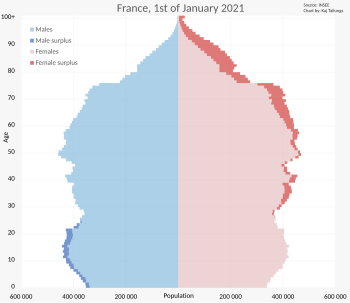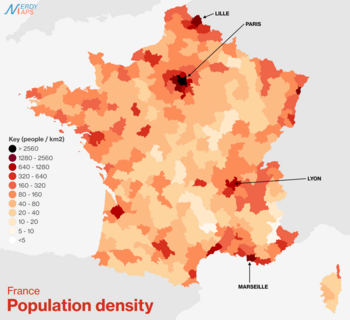
Demographics of France
From Wikipedia, the free encyclopedia
The demography of France is monitored by the Institut national d'études démographiques (INED) and the Institut national de la statistique et des études économiques (INSEE). As of 1 January 2021, 65,250,000 people lived in Metropolitan France, while 2,785,000 lived in overseas France, for a total of 68,035,000 inhabitants in the French Republic.[5]
| Demographics of France | |
|---|---|
 Population pyramid, 2021 | |
| Population | 68,035,000 (January 2021)[1] |
| Birth rate | 11.0 births/1,000 population (2020)[2] |
| Death rate | 10.0 deaths/1,000 population (2020)[2] |
| Life expectancy | |
| • male | 79.2 |
| • female | 85.2 |
| Fertility rate | |
| Infant mortality rate | 3.6 deaths/1,000 live births (2020)[4] |
| Age structure | |
| 0–14 years | 17.5% (2021)[2] |
| 15–64 years | 61.5% (2021)[2] |
| 65 and over | 21.0% (2021)[2] |



In March 2017, the population of France officially reached the 67,000,000 mark. It had reached 66,000,000 in early 2014.[6] Between the years 2010–17, the population of France grew from 64,613,000 to 66,991,000 (i.e. about 2.4 million people in a span of 7 years), making France one of the fastest-growing countries in Europe. The population of France is growing by 1,000,000 people every three years- an average annual increase of 340,000 people, or +0.6%.[7]
France was historically Europe's most populous country. During the Middle Ages, more than one-quarter of Europe's total population was French;[8] by the seventeenth century, this had decreased slightly to one-fifth. By the beginning of the nineteen century, other European countries, such as Germany and Russia, had caught up with France and overtaken it in number of people. However, the country's population sharply increased with the baby boom following World War II. According to INSEE, since 2004, 200,000 immigrants entered the country annually. One out of two was born in Europe and one in three in Africa. Between 2009 and 2012, the number of Europeans entering France increased sharply (plus 12% per year on average), but would steadily decline by 2022, as more Africans began entering France.[9][10][11]
The national birth rate, after dropping for a time, began to rebound in the 1990s and currently the country's fertility rate is close to the replacement level. According to a 2006 INSEE study, "the natural increase is close to 300,000 people, a level that has not been reached in more than thirty years."[12] With a total fertility rate of 1.83 in 2020,[3] France however remains the most fertile country in the European Union.[13][14]
Among the 802,000 babies born in metropolitan France in 2010, 80.1% had two French parents, 13.3% had one French parent, and 6.6% had two non-French parents.[15][16][17]
Between 2006 and 2008, about 22% of newborns in France had at least one foreign-born grandparent (9% born in another European country, 8% born in the Maghreb and 2% born in another region of the world).[18] Censuses on race and ethnic origin were banned by the French government in 1978.[19]
In 2021, the Total Fertility Rate of France was 1.82, and 7.7% was the percent of births to women that were their 4th+ child.